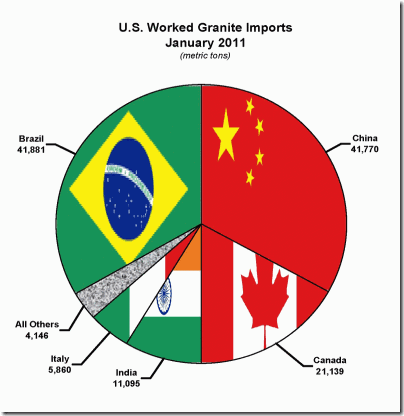Note: While the this blog is devoted to dimensional stone and allied subjects, Diversion offers some not-so-off-topic insights … including some thoughts on technology.
When it comes to quoting the ultimate authority, someone in a crowd is bound to utter, “I read it in the New York Times.” And, by and large, what’s printed in the Times is good authority … unless it happens to be part of a rather clever PR strategy like, uh, radon and killer countertops.
No, this isn’t another journey into the land of picoliters. Instead, let’s take a look at some rather declarative Times advice about personal technology, as presented in this March 23 Sam Grobart article at nytimes.com: “Gadgets You Should Get Rid Of (or Not)”.
Rather than quote extensively – you can read the whole thing yourself, but don’t trip on that new paywall – I’ll offer the list and the short summary of the device.
Desktop computer: Lose it (laptops are just as good).
High-Speed Internet at Home: Keep it (it’s better than a cell-phone-based hookup).
Cable TV: Depends (mainly good for sports freaks).
Point-and-Shoot Camera: Lose it (smartphones are great).
Camcorder: Lose it (smartphones are great).
USB Thumb Drive: Lose it (cloud computing is better).
Digital Music Player: Lose it (smartphones are great).
Alarm Clock: Keep it (simpler than a smartphone).
GPS Unit: Lose it (smartphones are great).
Books: Keep them (no batteries needed, available at libraries).
Since I’ve lived most of my years as a contrarian, I have no problem disagreeing with most of Mr. Grobart’s list – in that I’m not in favor of losing any of the gadgets on the toss list. For now, keep ‘em all.
I’m sure Mr. Grobart’s thinking of the casual users of technology who catch streaming-video presentations of half-hour sitcoms and take videos of the kids’ birthday parties. If you’re not really depending on any of these devices, maybe it’s time to simplify your next round of device buys.
However, if you’re using any of these devices in any way that’s related to business – or you’re going to wander 20 miles or so away from a U.S. metropolis for any reason – don’t trim that gadget list. You’ll need them.
As a personal-computer owner since 1986, I’ve seen plenty of developments, but none match the performance-per-dollar you’ll get from that unsexy utilitarian desktop. Not that I’d disdain a laptop – I own several – but the portable is prone to more wear-and-tear, not to mention the possibility of loss or theft. Laptops also tend to promote a user reliance on wifi Internet connection, which is far from universal or ideal in many circumstances.
When the ‘Net is absent, a thumb drive is invaluable. While I use the online cloud concept (Microsoft’s SkyDrive, for example), it’s a no-brainer to carry a little USB stick for documents, presentations and photos. It also allows the use of someone else’s computer – I posted several items from Coverings using press-room computers, transferring work from a wifi-dead laptop. (If you get clever, you can copy your DVDs to AVI or MPEG files to a thumb drive and watch them on a laptop while traveling.)
Where I don’t get clever is with my mobile phone. To be very honest, I don’t have a smartphone; for one thing, I’m not keen to dish out another $400-$500 just in connection fees. And, in 25 years of owning personal technology, I’ve learned that the more tasks you assign to one device, it’s more-certain that you’re going to brick it.
Smartphones are marvelous pieces of technology, but their main purpose is enabling voice calls. Yes, you can do hundreds of other tasks with a smartphone, but it doesn’t do them as well as specifically designed devices like GPS units or point-and-shoot cameras.
It’s a major shock for some people to learn that large areas of the United States outside major metro areas have gaps in cellular service; hit a soft spot, and something like GPS goes dark. And photo/video recording quality remains relatively low on smartphones when compared to the cheapest camera or pocket camcorder.
Trying to make that smartphone do all these things pushes it closer to breakdown; keep ordering it to do more and, like most other electronic devices, it hits the limit and seizes up. If you’ve tossed everything else, you’ll be left holding a very expensive electronic brick.
Sure, this sounds like the old guy who just isn’t getting it, and he should just move on. But, in a quarter-century, I’ve learned that every good gadget has its reason for being in my bag of technology tricks – and I’ll need a better reason for pitching them than a New York Times say-so.
You can read up-to-the-minute news on the dimensional-stone trade and search the archives at Stone Business Online, where you can also find this blog at the Main Menu under the clever heading of “Blogs.”
Get the best in insightful and informed coverage of the stone industry every month with Stone Business magazine. Sign up for a free subscription (or renew your current account) and don’t miss a single issue – just click here.
The advertisements that appear on this page are placed by wordpress.com, and constitute no endorsement of the products or services. And I don’t get a dime from any of them, either.



